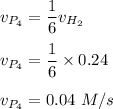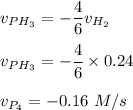
Chemistry, 27.01.2020 22:31 jbrown76241
Consider the reaction
4ph3(g) → p4(g) + 6h2(g)
suppose that, at a particular moment during the reaction, molecular hydrogen is being formed at rate of 0.240 m/s.
(a) at what rate is p4 changing?
m/s
(b) at what rate is ph3 changing?
m/sf

Answers: 2


Another question on Chemistry

Chemistry, 22.06.2019 10:30
What is the empirical formula of c6h18o3? ch3o c2h5o c2h6o c2h5o5
Answers: 1

Chemistry, 22.06.2019 16:00
Is a measure of the resistance to flow. a high liquid has a high resistance to flow and flows slowly. the ancients thought everything in the world was made of 4 we now know that there are 94 naturally occurring and scientists have created another 24 i am certain they will create even more. honey flows slowly because it has a high to flowing. a can be separated by physical means because it contains more than one pure substance and 2 pure substances are not chemically bonded to each other. a cannot be separated by physical means. all matter is made up of all elements are with the same number of protons. if it is just a single or many bonded together, if all of them have the same number of protons, it is an element. in a piece of pure iron metal, all the are joined together, that piece of iron metal is called elemental iron. a single of iron is called elemental iron. a mixture has differences from place to place. we might need a microscope to see them or they might be obvious to the unaided eye. there are surfaces separating it into different phases. a mixture is the same everywhere. it is uniform. there are no surfaces separating it into different phases. if different kinds of atoms (different elements) are bonded together by their electrons, it is called a there are physical means of to isolate the different pure substances in a mixture and there are chemical means of to isolate the different elements in a compound. 1. element 2. compound 3. mixture 4. heterogeneous 5. homogeneous 6. pure substance 7. atoms 8. separation 9. viscosity 10. resistance
Answers: 2

Chemistry, 22.06.2019 16:30
How many moles of sulfuric acid (h2so4) are needed to react completely with 6.8 moles of lithium hydroxide (lioh)? 2lioh + h2so4 → li2so4 + 2h2o a. 3.4 mol h2so4b. 6.8 mol h2so4 c. 10.2 mol h2so4 d. 13.6 mol h2so4
Answers: 3

Chemistry, 23.06.2019 00:00
Predict the relative bond lengths of the three carbon-oxygen bonds in the carbonate ion (co2−3). what would you expect the charge to be on each oxygen? match the words in the left column to the appropriate blanks in the sentences on the right. make certain each sentence is complete before submitting your answer.
Answers: 3
You know the right answer?
Consider the reaction
4ph3(g) → p4(g) + 6h2(g)
suppose that, at a particular...
4ph3(g) → p4(g) + 6h2(g)
suppose that, at a particular...
Questions

Mathematics, 27.10.2020 08:30







Biology, 27.10.2020 08:40

Mathematics, 27.10.2020 08:40


Mathematics, 27.10.2020 08:40

Biology, 27.10.2020 08:40


Mathematics, 27.10.2020 08:40

Geography, 27.10.2020 08:40



Law, 27.10.2020 08:40

Mathematics, 27.10.2020 08:40



![\displaystyle v=-\frac{1}{4}\frac{\Delta [PH_3]}{\Delta t}=+\frac{\Delta [P_4]}{\Delta t}=+\frac{1}{6}\frac{\Delta [H_2]}{\Delta t}](/tpl/images/0473/7108/0b5ff.png)





